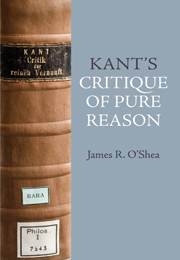Book contents
- Frontmatter
- Contents
- Preface
- INTRODUCTION
- 1 METAPHYSICS AND THE “FIERY TEST OF CRITIQUE”
- 2 WAKING FROM DOGMATIC SLUMBERS: HUME AND THE ANTINOMIES
- 3 SPACE AND TIME AS FORMS OF HUMAN SENSIBILITY
- 4 THE CATEGORIES OF UNDERSTANDING AND THE THINKING SELF
- 5 ONE LAWFUL NATURE
- 6 CONCLUSION: PURE REASON'S ROLE IN KANT'S METAPHYSICS OF NATURE
- Bibliography
- Index
1 - METAPHYSICS AND THE “FIERY TEST OF CRITIQUE”
- Frontmatter
- Contents
- Preface
- INTRODUCTION
- 1 METAPHYSICS AND THE “FIERY TEST OF CRITIQUE”
- 2 WAKING FROM DOGMATIC SLUMBERS: HUME AND THE ANTINOMIES
- 3 SPACE AND TIME AS FORMS OF HUMAN SENSIBILITY
- 4 THE CATEGORIES OF UNDERSTANDING AND THE THINKING SELF
- 5 ONE LAWFUL NATURE
- 6 CONCLUSION: PURE REASON'S ROLE IN KANT'S METAPHYSICS OF NATURE
- Bibliography
- Index
Summary
The advantage is entirely on the side of pneumatism [the metaphysics of the soul], even though pneumatism cannot deny that radical defect through which its entire plausibility dissolves into mere haze when put to the fiery test of critique.
(Kant, Critique of Pure Reason, A406/B433)RATIONAL METAPHYSICS: THE HIGHEST AIMS OF SPECULATIVE REASON
When the Critique of Pure Reason appeared in 1781, it was clear that Kant intended both to tear down and to rebuild, on entirely new ground, one of philosophy's most prized and ancient disciplines: rational metaphysics. But what is rational metaphysics? And why did Kant believe that ‘pure reason’ stands in need of criticism? In this chapter and the next we shall be focusing primarily on Kant's criticisms of traditional metaphysics, with brief glimpses ahead to Kant's own revolutionary ‘transcendental’ or ‘critical’ solution to the problems of metaphysics, to be examined more thoroughly in subsequent chapters.
What is metaphysics?
In his Lectures on Metaphysics, Kant certainly makes clear to his students the high esteem in which he holds metaphysics. (These lectures were delivered over several decades at the University of Königsberg and were transcribed by capable students.) Here is one sample:
Metaphysics is the spirit of philosophy. It is related to philosophy as the spirit of wine is to wine. It purifies our elementary concepts and thereby makes us capable of comprehending all sciences. In short, it is the greatest culture of the human understanding.
(Kant, Lectures on Metaphysics [Mrongovius, 1782–3], 286=29:940)- Type
- Chapter
- Information
- Kant's Critique of Pure ReasonAn Introduction and Interpretation, pp. 13 - 39Publisher: Acumen PublishingPrint publication year: 2011



